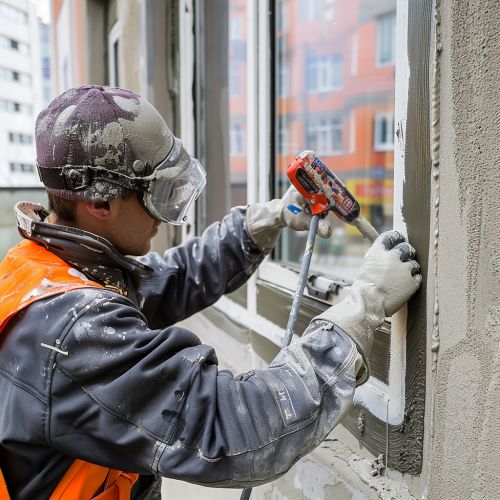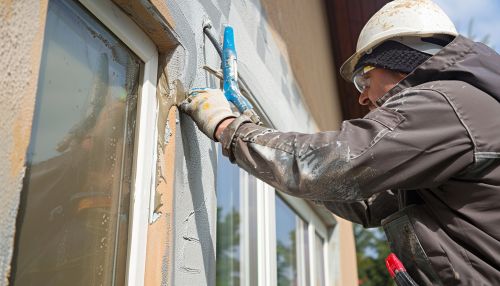Weatherproofing
Introduction
Weatherproofing refers to the process of making a structure or object resistant to the effects of weather, particularly precipitation, wind, and temperature fluctuations. This practice is essential for maintaining the integrity and longevity of buildings, vehicles, and other structures exposed to environmental elements. Weatherproofing involves a variety of techniques and materials designed to prevent water infiltration, reduce thermal transfer, and protect against wind damage.
Historical Context
The concept of weatherproofing dates back to ancient civilizations. Early humans used natural materials such as clay, straw, and animal hides to create shelters that could withstand harsh weather conditions. The development of more advanced weatherproofing techniques paralleled advancements in construction and material science. For instance, the Romans utilized concrete and waterproofing compounds to build aqueducts and structures that have endured for centuries.
Materials and Techniques
Sealants and Caulks
Sealants and caulks are essential for filling gaps and cracks in buildings to prevent water infiltration. These materials are typically made from silicone, polyurethane, or acrylic. Silicone sealants are highly flexible and durable, making them ideal for areas subject to significant movement, such as window frames and expansion joints. Polyurethane sealants offer excellent adhesion and are often used in exterior applications. Acrylic caulks are more affordable and suitable for interior use.
Weatherstripping
Weatherstripping involves the application of materials around doors and windows to prevent drafts and improve energy efficiency. Common weatherstripping materials include foam tape, felt, vinyl, and metal. Each material has specific advantages; for example, foam tape is easy to install and provides good insulation, while metal weatherstripping offers superior durability and resistance to wear.
Roofing Materials
The choice of roofing material plays a critical role in weatherproofing. Options include asphalt shingles, metal roofing, clay tiles, and synthetic membranes. Asphalt shingles are popular due to their affordability and ease of installation. Metal roofing offers excellent durability and resistance to extreme weather conditions. Clay tiles provide a traditional aesthetic and are highly resistant to fire and moisture. Synthetic membranes, such as EPDM and TPO, offer superior waterproofing and flexibility.
Siding and Cladding
Siding and cladding protect the exterior of buildings from weather damage. Common materials include vinyl, wood, fiber cement, and metal. Vinyl siding is low-maintenance and resistant to moisture and insects. Wood siding offers a natural appearance but requires regular maintenance to prevent rot and decay. Fiber cement siding combines the durability of cement with the aesthetic appeal of wood. Metal cladding provides excellent protection against wind and moisture but can be prone to denting.
Advanced Weatherproofing Technologies
Liquid-Applied Membranes
Liquid-applied membranes are a modern weatherproofing solution that involves applying a liquid coating to surfaces, which then cures to form a seamless, waterproof barrier. These membranes are commonly used on roofs, foundations, and balconies. They offer excellent flexibility and can accommodate structural movements without compromising their waterproofing properties.
Smart Materials
Smart materials, such as phase-change materials (PCMs) and self-healing coatings, are gaining popularity in weatherproofing applications. PCMs can absorb and release thermal energy, helping to regulate indoor temperatures and reduce energy consumption. Self-healing coatings contain microcapsules that release repair agents when damaged, automatically sealing cracks and extending the lifespan of the weatherproofing layer.
Green Roofs
Green roofs, also known as living roofs, involve the installation of vegetation on rooftops. This approach provides natural insulation, reduces stormwater runoff, and improves air quality. Green roofs require a waterproof membrane, drainage layer, and appropriate soil and plant selection to ensure their effectiveness and longevity.
Weatherproofing in Different Climates
Cold Climates
In cold climates, weatherproofing focuses on preventing heat loss and protecting structures from snow and ice damage. Insulation is critical, with materials such as fiberglass, foam board, and spray foam commonly used. Ice dams, which form when snow melts and refreezes at the roof edge, can be prevented with proper attic ventilation and the installation of ice and water shields.
Hot Climates
Weatherproofing in hot climates aims to reduce heat gain and protect structures from intense sunlight and high temperatures. Reflective roofing materials, such as cool roofs, can significantly reduce heat absorption. Proper insulation and shading devices, such as awnings and reflective window films, help maintain comfortable indoor temperatures and reduce energy consumption.
Humid Climates
In humid climates, preventing moisture infiltration and controlling humidity levels are paramount. Vapor barriers are essential to prevent condensation and mold growth. Dehumidifiers and proper ventilation systems help maintain indoor air quality and prevent moisture-related damage.
Windy and Coastal Areas
Structures in windy and coastal areas require robust weatherproofing to withstand high winds and saltwater exposure. Reinforced roofing materials, impact-resistant windows, and corrosion-resistant coatings are critical. Additionally, structures may need to be elevated or designed with breakaway walls to mitigate flood damage.
Maintenance and Inspection
Regular maintenance and inspection are crucial for effective weatherproofing. Homeowners and property managers should routinely check for signs of wear and damage, such as cracked sealants, loose shingles, and deteriorated siding. Prompt repairs and replacements can prevent minor issues from escalating into significant problems.
Environmental and Economic Considerations
Weatherproofing not only protects structures but also contributes to energy efficiency and sustainability. Proper insulation and sealing reduce the need for heating and cooling, lowering energy consumption and greenhouse gas emissions. Additionally, weatherproofing can extend the lifespan of buildings and reduce maintenance costs, offering long-term economic benefits.
Conclusion
Weatherproofing is a vital aspect of building construction and maintenance, ensuring structures remain resilient against environmental elements. Advances in materials and technologies continue to enhance the effectiveness and efficiency of weatherproofing solutions. By understanding and implementing appropriate weatherproofing techniques, individuals and organizations can protect their investments and contribute to a more sustainable future.


